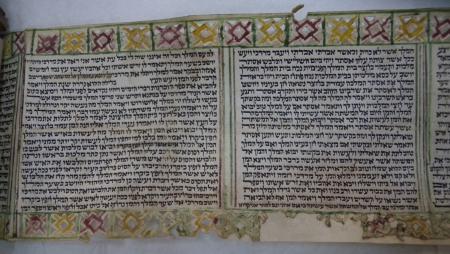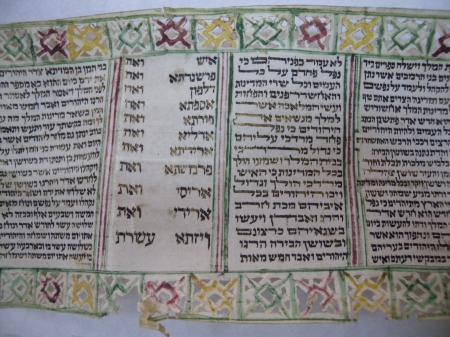Obj. ID: 34769
Hebrew Illuminated Manuscripts Hechal Shlomo Esther Scroll with a Cut-Out Geometric Pattern, Morocco (?), 19th century

The upper and lower margins along with the manuscript are decorated with a cut-out geometric pattern formed of colorful diamonds framed in rectangles. The text panels are separated by colorful vertical lines.
The scroll is mounted on a wooden rod.
The majority of currently known megillot decorated with cut-out borders were produced in two localities: Italy (most likely in the area fo Lugo and Ancona) and Holland. For other scrolls decorated with cut-out borders see IDs: 34768 (different style of ornamentation),
sub-set tree:
Lenght of the membranes in the scroll: 1) ca. 365 mm, 2) 365 mm, 3) 545 mm.
Dimensions of the selected details in the scroll:
- decorative belts along the margins: ca. 13 mm;
- an average text panel: 75x70-80 mm
An average letter is 2 mm high, whereas the letters in col. 13 are nearly 4 mm high.
The rod: 255 mm.
The scroll is formed of 3 membranes containing 16 text columns with 18-22 lines except for col. 13 that is written in 11 lines divided into two parts.
The text is written in black ink in the Hebrew square Oriental script, on the flesh side of parchment sheets.
The spaces between the subsequent lines of the text vary. This together with the differentiated number of the text lines causes that the density of the text in the columns is different.
The letter ח (Es. 1:6) is enlarged. Also, the letter ת (Es. 9:29) is slightly larger than an average letter in the scroll.
In many columns, left margins are not straight.
The parchment is thin and at the same time, very stiff; the blank side of sheets is smooth and darker.
The ruling is made with a stylus along with the sheets. The lines are especially well visible in the blank spaces.
The membranes are stitched.
Yehuda L. Bialer, Estelle Fink, Jewish Life in Art and Tradition. From the Collection of the Sir Isaac and Lady Edith Wolfson Museum, Hechal Shlomo, Jerusalem, Jerusalem 1980, 172.












